Home » Gemstones » Green Gemstones
Green Gemstones and Crystals
Green is a very popular gemstone color. There are many green gems.
Author: Hobart M. King, PhD, GIA Graduate Gemologist

Green Gemstones and Crystals: A stunning collection of green crystals and faceted green gems. Image by Greg C Grace / Alamy Stock Photo.
Top row, from left to right: an oval-cut tsavorite (green garnet) gemstone; a step-cut oval dark green emerald gemstone; an emerald-cut dark green emerald gemstone; a light green oval-cut hiddenite (green spodumene) gemstone.
Second row: a natural emerald crystal; a natural prismatic crystal of green tourmaline.
Third row: a water-worn prismatic crystal of green corundum (fancy sapphire); a rectangular step-cut green peridot gemstone; a natural prismatic crystal of chrome (dark green) diopside.
Bottom row: a dark green cushion-cut green (fancy) sapphire; a natural intergrown crystal of green fluorite; a rectangular step-cut green tourmaline gemstone; an oval-cut dark green zircon gemstone.
| Emerald |

Emerald:
Emerald is the deep green color variety of the mineral known as beryl. To be an emerald, a beryl must have a rich green color that ranges between bluish green, green, and slightly yellowish green. Pale green specimens and those outside of the required color range should be called "green beryl."
Today, emerald, together with ruby and sapphire, generate more economic activity than all of the other colored gemstones combined. In many years, the dollar value of emeralds imported into the United States exceeds the value of ruby and sapphire combined.
Emerald is only found in a few locations worldwide. It is found only in those rocks where enough beryllium to produce beryl was present at the same time that chromium or vanadium were present to give the gem its color. As a result, most of the world's emeralds are mined in just four countries: Colombia, Zambia, Brazil, and Zimbabwe. In the United States, a few occurrences of emerald have been found in North Carolina.
Emerald is rare, it has a very high price, and natural emeralds are usually marked with fractures and abundant inclusions. In response, laboratory-created emeralds are now more abundant in mall and department store jewelry displays than natural stones. Consumers enjoy their visually perfect clarity and exceptional color, along with a price that is a fraction of what would be paid for natural stones of similar color, size, and clarity. They have the same chemical, physical, and optical characteristics as natural emeralds.
Image copyright iStockphoto / Epitavi.
Table of Contents
 Emerald Emerald Tsavorite Tsavorite Jade Jade Malachite Malachite Peridot Peridot Diopside Diopside |
| Tsavorite |
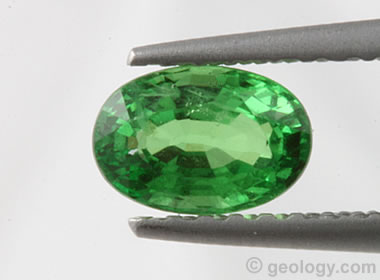
Tsavorite:
Green garnets? Most people have never heard of tsavorite and would be surprised to learn that it is a green garnet. Tsavorite has a wonderful bright green color, and its clarity is superior to emeralds of much higher price for a similar-size gem.
Tsavorite was discovered in 1967 near the community of Lemshuko in northeastern Tanzania. The prospectors who found it tried to get government permission to open a mine but were denied. So, they searched for similar rock units in neighboring parts of Kenya and discovered tsavorite there in 1971.
The gem was first promoted by Tiffany and Company, who gave it the name "tsavorite" - what a cool name! It was named after Tsavo East National Park in Kenya, near where the gem was first mined. Tsavorite has become a gem that is desirable in its own right and serves as an alternative gem for emerald. It is less expensive than emerald, but has a higher clarity and is more resistant to breaking. It is a little softer than emerald but hard enough to be used in almost any type of jewelry.
| Malachite |
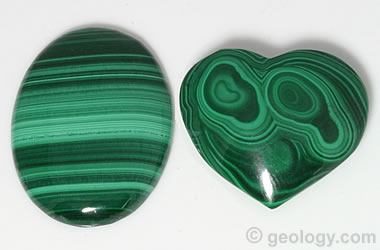
Malachite:
Malachite has been used as a gemstone and sculptural material for thousands of years and is still popular today.
People enjoy malachite's range of vivid green colors, its bright polish, and the bands and eyes displayed on polished surfaces. Its green color does not fade over time, and that is why powdered malachite has been used as a pigment and coloring agent for thousands of years.
Malachite is a popular material for producing cabochons and beads. It is also cut into thin strips that are used as inlay materials or to make small boxes and ornamental objects.
Although Malachite is popular, its use is limited because it is brittle and has a hardness of only 3.5 to 4. It is not suitable for use in a ring, bracelet, or other jewelry item that might suffer abrasion or impact. In jewelry, malachite is best used in pendants, pins, and earrings.
| Jade |
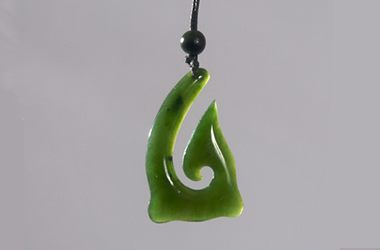
Jade:
Jade is a cultural term for a very durable and often beautiful gem material. Although most people immediately associated jade with China, it has been found in other parts of the world and used as a gem and ornamental stone for thousands of years.
Up until the 1860s, mineralogists thought that all jade was the same; then they discovered that two minerals with slightly different properties, jadeite and nephrite, were both used as jade. However, Chinese jade artists, who work with the stone every day, knew that jadeite was a superior material for producing fine gems and carvings. The name "jade" persists in common usage because it is familiar; however, experts who know their jade understand the differences between nephrite and jadeite.
People who buy jade must be very careful because many similar minerals are misidentified as jade. Numerous imitation materials are also used to produce jewelry and ornamental items and passed in the market as jade. If you don't know how to distinguish these materials, it is very important to buy from a trusted store or dealer.
Photo copyright iStockphoto / Steve Patterson.
| Diopside |

Diopside:
Diopside is a beautiful and relatively inexpensive gemstone that is occasionally seen in commercial jewelry. Specimens that contain chromium have a brilliant green color. Many people who see chrome diopside in a jewelry display initially think that it is an emerald. Then they are surprised to learn it is a gem they have never heard about.
Diopside is a gem best used in earrings, pendants, pins, and brooches because it has a low hardness and fragile cleavage. It is unsuitable for rings and bracelets unless it is placed in a setting that will provide protection against abrasion and impact.
In addition to the green chrome diopside, the gem occurs in two different appearances. One is a translucent light blue to purple granular material known as "violane" which is used for cabochons, beads, and ornamental projects. The other, called "star diopside," is a dark opaque gem with a silk of fine inclusions that, when cut into cabochons, exhibits asterism.
| Peridot |
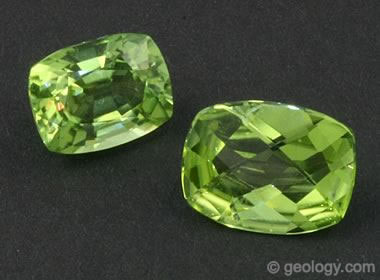
Peridot:
Peridot is the name given to specimens of yellowish green to bright green olivine that are suitable for producing gems. Peridot serves as the birthstone for the month of August, and that contributes to its customer awareness and popularity.
Most gem-quality peridot is found in basalt flows, limestones, and dolomites. Much of the world's commercial-quality peridot is mined at the San Carlos Reservation in Arizona. There, a few basalt flows contain nodules of granular olivine that are the source of peridot. This peridot is sent to Asia for cutting and returned to the United States mounted in department store jewelry. Higher quality peridot forms as large crystals during the metamorphism of limestone and dolomite. These deposits are located in Pakistan and Myanmar.
Pallasite meteorites often contain gem-quality crystals of olivine that can be cut into small but interesting gemstones. These are some of the few gemstones on Earth that have an extraterrestrial origin. They are usually small, extremely expensive gems but tremendously interesting.
| More Gemstones |
 |
Birthstones |
 |
Diamond |
 |
Blue Gemstones |
 |
100+ Gems |
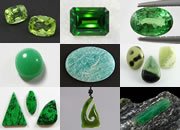 |
Green Gemstones |
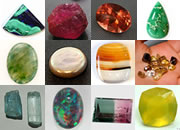 |
Mined in America |
 |
Ruby and Sapphire |
 |
Tumbled Stones |

Find Other Topics on Geology.com:

|

| ||

|

| ||

|

| ||

|

|
